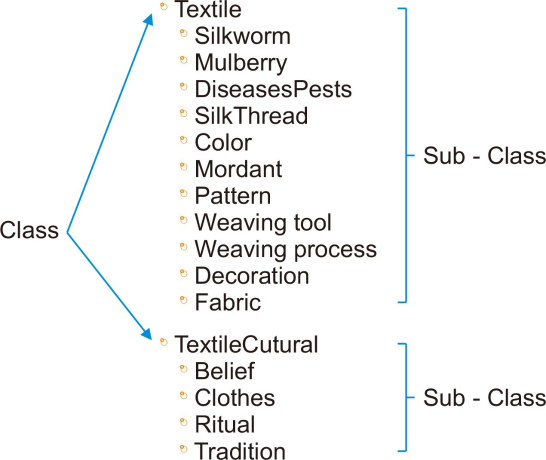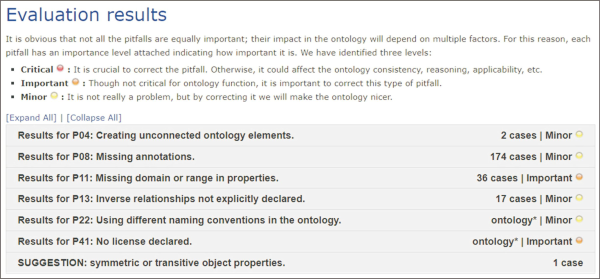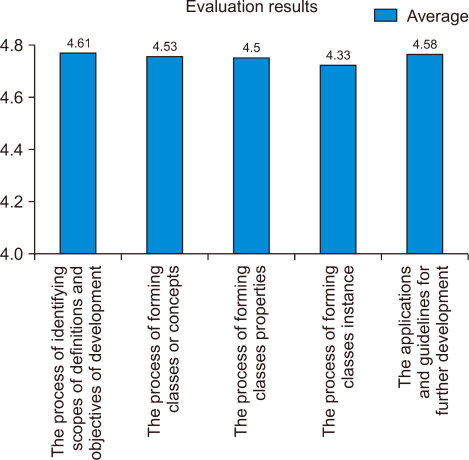1. INTRODUCTION
Recently, each country has been trying to support every sector in terms of applying cultural knowledge as a foundation for national improvement, since cultural knowledge relates to values, practices, and innovations to correspond to the needs of communities. Furthermore, cultural knowledge reflects the environment and ways of life (Wei Choo, 2000). Therefore, the cultural knowledge of each community tells stories related to culture in order to demonstrate the significance of the community’s culture. This was also the foundation for countries’ product and service development and innovation (Howkins, 2002; Iamkhajornchai & Manmart, 2018).
Textiles can portray a culture’s core values, which is a significant capital to build on existing knowledge. In the past, textiles were considered one of the economic indicators which could be sold or traded with other goods or money. Also, textiles are counted as cultural capital since they are bound with traditions, rituals, and ways of life (Pogodina et al., 2021). For example, people use textiles as offerings in rituals or make textiles as ethnic costumes. More than this, culture in textiles is bound with social values, especially regarding women and textiles, and it reflects patience, handicraft, and creativity.
Additionally, ways of culture in textiles from birth to death can demonstrate capital in religions and traditions since beliefs regarding religions and traditions are attached in every step of the weaving process. Textiles describe their legacies in cultural knowledge, identity, local wisdom, and weaving skills (Sakamoto, 2014). Therefore, textiles are not only for daily use or aesthetics, but they are resources in the culture of ethnic groups which illustrate contexts in history and culture (Martins et al., 2013) to develop products further because all knowledge of textiles lies within each fabric: preparing threads, colors, patterns, weaving tools, weaving process, weaving techniques, and decorations. These elements are in each fabric of the Thai-Khmer ethnic group as reflected in ways of life, rituals, traditions, and beliefs.
Cultural knowledge in each area is different due to distinctive geography, climate, natural surroundings, needs, and ethnic groups. The abovementioned concepts lead to adaptations and unique ways of life, beliefs, culture, traditions, tools, and needs. When ethnic groups migrated, they often brought their culture with them. Therefore, we can distinguish the uniqueness of each ethnic group. For instance, in Lawa costume, women often wear dark blue or black sleeveless shirts called Pok Tia or Koh in Thai. For the So ethnic group, women wear ikat or cotton sarongs with black button-up shirts decorated with red threads and a breast cloth.
Nevertheless, married women do not decorate their shirts with red threads. Instead, Thai-Khmer women wear sarongs which are Hol, Umprom, Unloonseem, and Sakoo, and shirts. Hence, cultural knowledge in textiles can identify specific characteristics of each ethnic group.
In accordance with the National Strategy on Diverse Tourism (2018-2037) and the Northeast Region Development Plan, Thai-Khmer ethnic groups’ woven textiles will be marketed globally (2018-2022). The textiles are to be a part of cultural tourism and souvenir sales. Thai-Khmer textiles have a number of distinctive characteristics (Office of the National Economic and Social Development Council, 2019; Office of Small and Medium Enterprises Promotion, 2017), including 1) premium-quality yarns for a piece of delicate and lustrous fabric; 2) silkworm farming, a superior form of natural farming; 3) only Thai Khmer-made woven fabrics use the wrap-and-weft ikat weaving techniques; 4) dyeing the hues red, yellow, black, green, and blue under the influence of the Khmer culture; 5) using natural dyes; and 6) Hol, Kanaw, Umprom, Unloonseem, Labek, Samore, Chanotluek, and Sakoo are original patterns (Boonpok, 2019).
Cultural knowledge of Thai-Khmer textiles could be applied to teaching, learning, and researching the weaving process and textile product developments. In accordance with studies by Arayaphan and Panommit (2019) and Iamkhajornchai and Manmart (2018), it was found that issues in cultural knowledge application were 1) knowledge classifications; even cultural knowledge of textiles is specific, as it was classified as common knowledge and placed in several categories. Consequently, users could no longer retrieve the cultural knowledge; 2) existing keywords; they do not cover all the content of cultural knowledge of textiles; and 3) keyword settings; each textile word is specific and called differently in each area. Moreover, some words in Thai share the same sounds or same forms which might cause misspellings. As a result, users might take time to retrieve and get inaccurate meanings. Therefore, a quality tool for retrieving cultural knowledge of textiles containing functional features, e.g., specific classifications and accurate keywords for global, local, and tribal use, should be developed for users to access the cultural knowledge of Thai-Khmer textiles faster.
Ontology is one of the helpful retrieval tools. It contains practical features for Thai-Khmer textile cultural knowledge such as setting representative words, specific properties, and relationship attributes, and developing relationships by using classes to show clear connections between classes, properties of each class, and instances. Employing classes in an ontology could provide accurate settings and share knowledge sets among the system. It also reduces redundancies in word uses (Uschold & Gruninger, 1996) and helps users retrieve and access this cultural knowledge effectively.
As a result, the development of an ontology in the cultural knowledge of Thai-Khmer textiles could help 1) set keywords representing standard concepts of cultural knowledge of Thai-Khmer textiles, 2) enhance a process’s automatic clear methodology for managing disputes and improving content, enabling a common namespace for Thai-Khmer textile terms that facilitates querying and understanding the relationships between concepts in a particular cultural knowledge domain, and 3) reduce redundancy and improve accuracy. Additionally, this ontology will be an alternative for the textile category to widely share cultural knowledge of Thai-Khmer textiles.
2. RESEARCH METHODOLOGY
In general, modeling is the process of creating a representation of a system or concept to understand it better and make predictions about it. Many different methodologies can be used for modeling, depending on the nature of the system or concept being studied and the research goals. Some common methodologies used in academic research include: 1) mathematical modeling, which involves using mathematical equations and simulations to represent a system and make predictions about it; 2) statistical modeling, which involves using statistical techniques to analyze data and build a model representing relationships within the data; 3) simulation modeling: This involves creating a computer program that simulates the behavior of a system over time; 4) conceptual modeling: This involves creating a diagram or other visual representation of a concept or system to better understand its structure and relationships; 5) prototyping: This involves creating a physical or digital prototype of a product or system in order to test and refine it; 6) case study: This involves in-depth analysis of a specific case or situation in order to understand it in more depth; 7) experimental design: This involves manipulating variables and measuring the results in order to understand the relationships between variables and to test hypotheses; and 8) grounded theory: This involves using inductive reasoning to develop a theory based on data collected through observations or interviews.
It is important to choose the most appropriate methodology for the research question being studied and to clearly describe the methodology used in the research in order to allow other researchers to replicate or build upon the work. Therefore, in this study, we chose the conceptual modeling methodology for constructing an ontology. Also, research and development research was employed, and there were three phases as follows:
Phase 1. Investigating applications of cultural knowledge of Thai-Khmer textiles. This was done to investigate how the target groups (university lecturers, scholars, weavers, entrepreneurs, and university students in Buriram and Surin provinces) applied cultural knowledge to gain insightful information regarding applications of the cultural knowledge of Thai-Khmer textiles, issues in applying the cultural knowledge of Thai-Khmer textiles, and suggestions to develop a quality tool for retrieving cultural knowledge of Thai-Khmer textiles.
Phase 2. Studies on structures of cultural knowledge in Thai-Khmer textiles. This phase was done to analyze data from four resources: Thai Journal Online, Thailand Library Integrated System, Thailand Culture Research, and Digital Research Information Center. After that, the structures were designed by applying the cultural frameworks of United Nations Educational Scientific and Cultural Organization (2003) and criteria for selecting the cultural heritage of the nation (Department of Cultural Promotion [Thailand], 2017). Then, the data was classified by classes, sub-classes, and divisions (Broughton, 2006; Kumar, 1992); moreover, the properties of cultural knowledge in Thai-Khmer textiles were analyzed by the Facet Classification Approach of Spiteri (1998).
Phase 3. Ontologies design of cultural knowledge in Thai-Khmer textiles. This was accomplished to develop a structure of cultural knowledge of Thai-Khmer textiles from the analyzed content, which was 1) textiles and 2) cultural knowledge of Thai-Khmer textiles and building an ontology. The researchers employed the ontology development frameworks of Noy and McGuinness (2001) and Uschold and King (1995) to get a body of ontology and evaluation. Processes in building ontologies were 1) generating objectives of ontologies, 2) building ontologies, 2.1) forming classes, sub-classes, and classifying class relationships, 2.2) setting properties, 2.3) creating keywords or data representatives, and 3) preparing two types of ontologies evaluations using OntOlogies Pitfall Scanner (OOPS!) (Poveda-Villalón, 2021) with six experts in ontologies and Thai-Khmer textiles. The tool for building ontologies was Protégé version 5.5 (Stanford University, 2021) and the tool for disseminating ontologies through World Wide Web was WIDOCO (Garijo, 2017), as shown in Fig. 1.
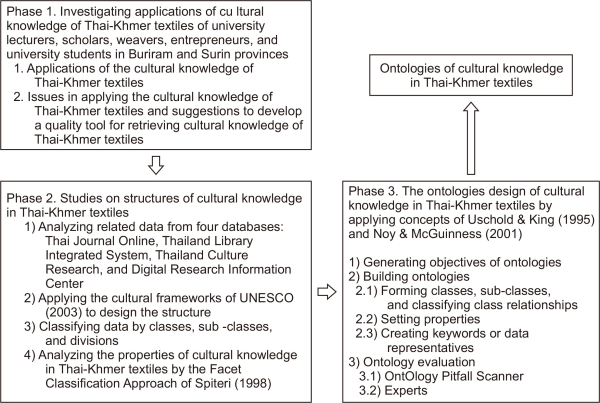
Research conceptual framework. UNESCO, United Nations Educational Scientific and Cultural Organization.
3. IMPLEMENTATION
The researchers built ontologies regarding cultural knowledge in Thai-Khmer textiles by using two classes: textiles and cultural knowledge in the textiles. This ontologies development applied the methodologies of Uschold and King (1995) and Noy and McGuinness (2001) in the form of 1) generating objectives of ontologies, 2) building ontologies, 2.1) setting classes, sub-classes, and classifying class relationships, 2.2) setting properties, and 2.3) creating keywords or data representatives, and 3) preparing two types of ontologies evaluations using OOPS! (Poveda-Villalón, 2021) with three experts in ontologies and three experts in Thai-Khmer textiles.
3.1. Generating Objectives of Ontologies
As a result of insufficient data and key terms regarding standard words, local words, cultural knowledge of textile words, and specific ethnic words, the ontology was developed and aimed at providing ease to users in retrieving and accessing data on cultural knowledge of Thai-Khmer textiles. Further, users would like databases to have more key terms regarding standard words, local words, cultural knowledge in textile words, and specific ethnic words. For example, when users searched for “Ka new fabric,” “Ka neaw fabric,” “Hang Ka Ronk silk,” and “Kuab fabric,” they got the same search result. To solve this problem, the researchers formed objectives in building ontologies regarding the cultural knowledge in Thai-Khmer textiles, as follows:
-
1) Provide easy access to cultural knowledge in Thai-Khmer textiles with related keywords.
-
2) Provide distinctive scopes of cultural knowledge in Thai-Khmer textiles with definitions, properties, characteristics, sample data, and relationships to ease users’ access and retrieve needed information.
After generating objectives, the researchers formed structures of the ontologies, including two main groups: textiles and culture in textiles. Then, these two groups were developed into a major domain called cultural knowledge in Thai-Khmer textiles, and finally, they were classified into ontologies of cultural knowledge in Thai-Khmer textiles.
3.2. Building Ontologies of Cultural Knowledge in Thai-Khmer Textiles
3.2.1. Forming Classes, Sub-Classes, and Relationships
The ontologies of cultural knowledge in Thai-Khmer textiles consist of two main classes and sixteen sub-classes: namely 1) the textile class, including silkworm, mulberry, diseases and pest, silk thread, color, mordant, pattern, weaving tool, weaving process, weaving techniques, decoration, and fabric, and 2) culture in textiles, including belief, clothes, ritual, and tradition, as shown in Fig. 2.
Forming relationships between classes in the ontologies of cultural knowledge in Thai-Khmer textiles by object properties can be classified as sixteen types of relationships, including MadeFrom, hasRelationship, hasColor, hasDyeAuxiliaries, DyeAuxiliariesOf, ToolOf, hasTool, UseFor, BeliefOf, hasBelief, ProcessOf, hasProcess, DeseaseOf, hasDesease, hasCloth, and ClothOf.
3.2.2. Forming Properties
The researchers investigated two existing ontologies, which were Prea-wa silk ontology, consisting of four classes: 1) production, 2) textile products, 3) textile types, and 4) patterns (Singthongchai et al., 2012); and Lanna textile ontology, consisting of four classes: 1) weaving materials, 2) weaving tools, 3) raw materials for textile production, 4) textile production process, and 5) weaving techniques (Arayaphan & Panommit, 2019), with the finding that the similar classes were patterns, production process, textile types, and textile products. Further, the researchers found that these two ontologies did not include cultural knowledge of textiles; therefore, classes of patterns, production processes, and textiles were applied along with cultural knowledge of textiles to the developed ontology.
3.2.3. Forming Keywords or Data Representatives
There are two class properties: object properties and datatype properties, which describe the properties of information access between classes through meaning. There were 69 class properties of the developed ontology consisting of 1) textile class, including 58 properties; e.g., the Disease and pest class includes two types of properties: object properties (Name, Cause, Period, Symptom, and Prevention) and datatype properties (String); and 2) culture of textiles, consisting of 11 properties; e.g., the Ritual class includes two types of properties: object properties (Name, Ritual nature, and Description) and datatype properties (String). Setting class properties helps picture cultural knowledge of Thai-Khmer textiles vividly. There are three data properties, including Name, Period, and Process. The Name property is a string data type used to contain any name class in the ontology. Period property is a string data type used for the beginning to the end of the moment. Process property is a string data type used for the procedure of class in the ontology. Examples of class and property definitions are in Tables 1 and 2.
3.2.4. Creating Individuals or Instances
The researchers examined cultural knowledge in Thai-Khmer textiles and scopes of knowledge structures to form individuals or instances by inserting data according to class properties and attributes. 493 instances included 1) textile class for 422 instances and 2) culture in textiles class for 71 instances. For more details of the whole instance or individual, please access online: http://reg-rdi.com/OntologyTextile/index-en.php#home.
3.3. Evaluations of the Ontologies of Cultural Knowledge in Thai-Khmer Textiles
The researchers employed two types of evaluation: 1) OOPS!, which detects defects regarding the structure, function, and usability. The application provides three recommendations: critical issues which the developers have to fix immediately, since defects affect the structure and might cause damages; important issues which the developers can fix later, since defects might not cause significant damages; and minor issues which the developers can fix, since defects might cause small damages to classes or relationships. The application results can help developers build effective ontologies (Chansanam et al., 2021; Poveda-Villalón et al., 2014).
Moreover, the application suggested 40 fixed issues and 2) expert evaluation consisting of two groups of experts who were purposively selected as three experts in ontologies and three experts in Thai-Khmer textiles. They were asked to evaluate five aspects of ontologies building processes: the process of identifying scopes of definitions and objectives of development, generating classes, forming properties of classes, setting instances of classes, and applications and guidelines for further development. The evaluation results are interpreted as average scores and then summarized with the descriptive analysis, as shown in Fig. 3.
3.4. WIDOCO-Presenting the Ontologies through World Wide Web: WWW with WIDOCO
The researchers brought WIDOCO to present the developed ontologies: 1) selecting a template to be the Ontologies Web Languages file, 2) uploading metadata, and 3) uploading the textile data, as shown in Fig. 4. Once the preparation is finished, all files of cultural knowledge in Thai-Khmer textiles will be uploaded and presented at http://reg-rdi.com/Texttile1/index-en.php, as shown in Fig. 5.
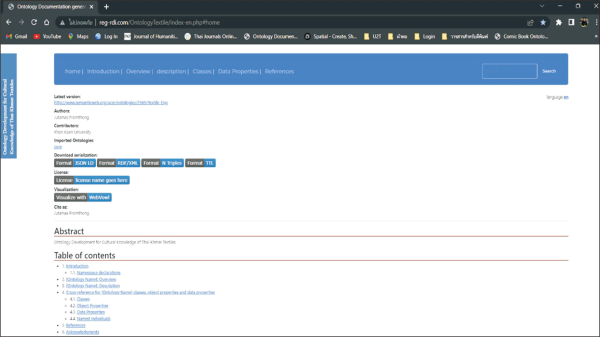
Screenshot of the ontologies of cultural knowledge in Thai-Khmer textiles through World Wide Web ( http://reg-rdi.com/OntologyTextile/index-en.php#home).
4. RESULT AND DISCUSSION
4.1. Result
4.1.1. The Classes of Cultural Knowledge Thai-Khmer Textiles Ontology
The ontologies of cultural knowledge in Thai-Khmer textiles consist of two classes, which are 1) textiles and 2) cultural knowledge in Thai-Khmer textiles. For the first class, there were 12 sub-classes: 1.1) Silkworm sub-class, consisting of 7 divisions, 3 meaning properties, 9 class properties, and 17 instances; 1.2) Mulberry sub-class, consisting of 5 divisions, 5 class relationships, 5 class properties, and 19 instances; 1.3) Diseases and pests sub-class, consisting of 2 divisions, 2 class relationships, 9 class properties, and 16 instances; 1.4) Silk threads sub-class, consisting of 2 class relationships, 4 class properties, and 3 instances; 1.5) coloring sub-class, consisting of 9 divisions, 3 class relationships, 6 class properties, and 52 instances; 1.6) Mordant sub-class, consisting of 2 divisions, 1 class relationshi, 2 class properties, and 23 instances; 1.7) Pattern sub-class, consisting of 12 divisions, 1 class relationships, 3 class properties, and 80 instances; 1.8) Weaving tools sub-class, consisting of 12 divisions, 2 class relationships, 4 class properties, and 59 instances; 1.9) Weaving processes sub-class, consisting of 3 divisions, 2 class relationships, 4 class properties, and 10 instances; 1.10) Weaving techniques sub-class, consisting of 4 divisions, 3 class relationships, 4 class properties, and 12 instances; 1.11) Decoration techniques sub-class, consisting of 4 class relationships and 6 instances; and 1.12) Fabric sub-class, consisting of 4 divisions, 3 class relationships, and 58 instances.
The second main class consists of 4 sub-classes, which are 2.1) Dressing sub-class, consisting of 6 divisions, 1 class relationship, 3 class properties, and 30 instances; 2.2) Rituals sub-class, consisting of 19 divisions, 1 class relationship, 2 class properties, and 36 instances; 2.3) Traditions sub-class, consisting of 7 divisions, 1 class relationship, 2 class properties, and 12 instances; and 2.4) Beliefs sub-class, consisting of 7 divisions, 1 class relationship, 2 class properties, and 37 instances.
4.1.2. Evaluations on The Ontologies of Cultural knowledge in Thai-Khmer Textiles
The results from the OOPS! application show seven issues to fix: 1) two issues of P04 Creating unconnected ontologies elements; 2) 173 issues of P08 Missing annotations in sub-class; 3) 36 issues of P11 Missing domain or range in properties; 4) 17 issues of P13 Missing inverse relationships; 5) one issue of P22 Using different naming criteria in the ontologies; 6) one issue of P41 No license declared; and 7) a suggestion of symmetric or transitive object properties.
Further, evaluation results from the experts revealed that the overall ontologies development was suitable at 4.51 on a 5-point Likert scale (Likert, 1967). However, the process of identifying scopes of definitions and objectives of development was 4.61, the applications and guidelines for further development was 4.58, and the process of forming classes or concepts was 4.53. The least suitable process was forming the class’s instance (4.33), as shown in Fig. 6.
4.2. Discussion
The cultural knowledge in Thai-Khmer textiles is distinctive and unique. According to the results, each class links to the other; for example, the pattern class relates to classes of weaving techniques, fabrics, and beliefs. The knowledge is a legacy, handed on from generation to generation. In addition, each generation has further developed patterns and weaving techniques to have various patterns of textiles. This goes along with Gruber’s (1995) finding that ontologies are basic knowledge formed by having specific domains and that it is important to reuse and add more values. Besides this, the present paper’s results revealed that the ontologies of cultural knowledge in Thai-Khmer textiles are specific, including plants used in the dying thread process, mordants, weaving tools, patterns, traditions, and rituals. Additionally, the ontologies show relationships among classes by meaning and keywords. In regard to Browne and Jermey (2004) and Taylor (2004), ontology is a process of generating a controlled vocabulary to explain objects and their relationships by terms, synonyms, properties, and instances; then creating relations by linking meaning with terms.
The ontologies of cultural knowledge in Thai-Khmer textiles are formal representations of a set of concepts within a domain and the relationships between those concepts. When built and used in a search or reasoning system, ontologies can provide several benefits:
-
1) Improved accuracy: By providing a clear and standardized structure for representing and organizing information, ontologies can help ensure that search results are more accurate and relevant.
-
2) Enhanced search functionality: Ontologies can enable more sophisticated search functionality, such as searching for conceptually related terms or narrowing down results based on specific relationships between concepts.
-
3) Better integration of diverse data sources: Ontologies can help integrate information from multiple sources by providing a shared vocabulary and structure for organizing that information.
-
4) Greater consistency in reasoning: Ontologies can support automated reasoning by providing a clear set of rules for inferring new information based on existing knowledge. This can lead to more consistent and reliable conclusions.
-
5) Increased reuse of knowledge: Ontologies can facilitate the reuse of knowledge by providing a clear and standardized representation of concepts and relationships that can be accessed and utilized by different systems and applications.
5. CONCLUSIONS
The ontologies of cultural knowledge in Thai-Khmer textiles are considered domain ontologies that store specific knowledge regarding cultural knowledge in Thai-Khmer textiles. The ontologies development was a top-down process accomplished by 1) generating classes in a domain of cultural knowledge in Thai-Khmer textiles from general definitions; 2) forming main classes, textiles and cultural knowledge in Thai-Khmer textiles; 3) forming sub-classes such as setting textiles class and adding sub-classes such as silkworm, mulberry, diseases, silk threads, color, mordant, weaving tools, weaving process, weaving technique, decoration, and fabrics; and 4) managing class relationships, setting main class and sub-class properties, and generating vocabulary or data representatives.
The evaluation results from the application and the experts revealed that the ontologies are suitable for further development in knowledge retrieval regarding the meaning and to further build cultural knowledge in other ethnic groups. Moreover, these ontologies could be further developed as a recommendation system of cultural knowledge to guide users regarding Thai-Khmer textiles.
In sum, using the ontologies of cultural knowledge in Thai-Khmer textiles can improve search and reasoning capabilities by providing a more structured and standardized representation of knowledge and enabling more sophisticated search and reasoning functionality.
REFERENCES
, (2019) Ontology development for knowledge of lanna textiles Journal of Human Sciences, 20(2), 133-170 https://so03.tci-thaijo.org/index.php/JHUMANS/article/view/213167.
(2006) The need for a faceted classification as the basis of all methods of information retrieval Aslib Proceedings, 58(1/2), 49-72 https://doi.org/10.1108/00012530610648671.
, , , , (2021) Thai tattoo wisdom's representation of knowledge by ontology Informatics, 8(1), 3 https://doi.org/10.3390/informatics8010003.
Department of Cultural Promotion (Thailand) (2017) Criteria for selecting the cultural heritage of the nation 2017 https://www2.m-culture.go.th/satun/ewt_dl_link.php?nid=1370
(1995) Toward principles for the design of ontologies used for knowledge sharing? International Journal of Human-Computer Studies, 43(5-6), 907-928 https://doi.org/10.1006/ijhc.1995.1081.
, (2018) Knowledge organization system and access of Thai cultural knowledge Journal of Information Science, 36(1), 1-40 https://so03.tci-thaijo.org/index.php/jiskku/article/view/104955.
, , (2013) Exploring weaving structures in the andes: Reflections on the creation of a digital archive Visual Resources, 29(1-2), 59-71 https://doi.org/10.1080/01973762.2013.761121.
, , (2014) OOPS! (Ontology Pitfall Scanner!): An on-line tool for ontology evaluation International Journal on Semantic Web and Information Systems, 10(2), 7-34 https://doi.org/10.4018/ijswis.2014040102.
, (1996) Ontologies: Principles, methods and applications Knowledge Engineering Review, 11(2), 93-136 https://doi.org/10.1017/S0269888900007797.
(2000) Working with knowledge: How information professionals help organisations manage what they know Library Management, 21(8), 395-403 https://doi.org/10.1108/01435120010342770.
